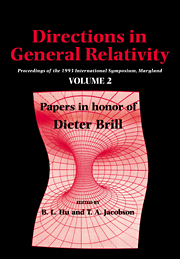 Directions in General Relativity
Directions in General Relativity Published online by Cambridge University Press: 06 January 2010
Abstract
In a parametrized and constrained Hamiltonian system, an observable is an operator which commutes with all (first-class) constraints, including the super-Hamiltonian. The problem of the frozen formalism is to explain how dynamics is possible when all observables are constants of the motion. An explicit model of a measurement-interaction in a parametrized Hamiltonian system is used to elucidate the relationship between three definitions of observables—as something one observes, as self-adjoint operators, and as operators which commute with all of the constraints. There is no inconsistency in the frozen formalism when the measurement process is properly understood. The projection operator description of measurement is criticized as an over-idealization which treats measurement as instantaneous and non-destructive. A more careful description of measurement necessarily involves interactions of non-vanishing duration. This is a first step towards a more even-handed treatment of space and time in quantum mechanics.
There is a special talent in being able to ask simple questions whose answers reach deeply into our understanding of physics. Dieter is one of the people with this talent, and many was the time when I thought the answer to one of his questions was nearly at hand, only to lose it on meeting an unexpected conceptual pitfall.
To save this book to your Kindle, first ensure [email protected] is added to your Approved Personal Document E-mail List under your Personal Document Settings on the Manage Your Content and Devices page of your Amazon account. Then enter the ‘name’ part of your Kindle email address below. Find out more about saving to your Kindle.
Note you can select to save to either the @free.kindle.com or @kindle.com variations. ‘@free.kindle.com’ emails are free but can only be saved to your device when it is connected to wi-fi. ‘@kindle.com’ emails can be delivered even when you are not connected to wi-fi, but note that service fees apply.
Find out more about the Kindle Personal Document Service.
To save content items to your account, please confirm that you agree to abide by our usage policies. If this is the first time you use this feature, you will be asked to authorise Cambridge Core to connect with your account. Find out more about saving content to Dropbox.
To save content items to your account, please confirm that you agree to abide by our usage policies. If this is the first time you use this feature, you will be asked to authorise Cambridge Core to connect with your account. Find out more about saving content to Google Drive.